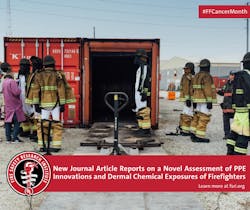The “Silicone passive sampling used to identify novel dermal chemical exposures of firefighters and assess PPE innovations” peer-reviewed journal article has been published in the International Journal of Hygiene and Environmental Health. The manuscript was authored by collaborators from Oregon State University, UL’s Fire Safety Research Institute (FSRI), Illinois Fire Service Institute (IFSI), National Institute for Occupational Safety and Health (NIOSH), and Skidmore College with data collected at the IFSI campus as part of the PPE Interface research project.
Combustion events release a number of chemicals into the air including a class of compounds called polycyclic hydrocarbons (PAH). Exposure to PAH compounds may increase firefighters’ risk for certain occupational cancers and cardiovascular events which are leading health concerns for structural firefighters. The personal protective equipment (PPE) typically worn by structural firefighters provides critical protection, but also has some vulnerabilities between turnout gear elements – such as the interface of the hood and jacket – that can allow for dermal chemical exposure.
The two primary objectives of this study are:
- To test the feasibility of using silicone sampling technology to assess dermal exposure to firefighters
- To compare dermal protection provided by PPE design typical of today’s fire service in the United States versus an experimental design with reduced PPE ensemble interface vulnerability
Results
The study utilized 16 mannequins dressed in PPE, placed inside a fireground exposure simulator for 10 minutes, and exposed to smoke from a burning couch. Silicone passive samplers were placed in vulnerable locations under PPE as well as within the simulator structure. PAH were measured to calculate the dermal protection for both the standard and experimental PPE.
Comparisons found higher PAH concentrations on mannequins dressed in standard PPE versus mannequins dressed in the experimental PPE with ensemble interface control elements. Mean worker protection factors for the experimental PPE were greater than standard PPE for 98% of the PAHs measured at the neck and chest. The experimental PPE design showed more than 30 times the protection than traditional bunker gear PPE against two highly carcinogenic PAH, dibenzo[a,l]pyrene and benzo[c]fluorine. Nine of the detected PAH in this study have not been previously reported in fireground exposure studies and 26 additional chemicals were detected using a large chemical screening method on a subset of the silicone sampling technology.
Conclusions
The study showed that silicone passive sampling appears to be an effective means for estimating dermal exposure risk to fireground smoke. It also provides evidence that reducing gaps in PPE interfaces could be further pursued as an intervention to reduce dermal exposure to PAH and other chemicals released during combustion events.
This manuscript is a component of Cardiovascular & Chemical Exposure Risk in Today’s Training Ground and PPE Interface Study. The study was supported by the FEMA Assistance to Firefighters Grant Program through a collaboration between two projects (EMW-2017-FP-00635 and EMW-2016-FP-00754). Additional support was provided by UL Research Institutes and National Institute of Environmental Health Sciences of the National Institutes of Health.
About International Journal of Hygiene and Environmental Health:
The International Journal of Hygiene and Environmental Health serves as a multidisciplinary forum for original reports on exposure assessment and the reactions to and consequences of human exposure to the biological, chemical, and physical environment. Research reports, short communications, reviews, scientific comments, technical notes, and editorials will be peer-reviewed before acceptance for publication. Priority will be given to articles on epidemiological aspects of environmental toxicology, health risk assessments, susceptible (sub) populations, sanitation and clean water, human biomonitoring, environmental medicine, and public health aspects of exposure-related outcomes.







